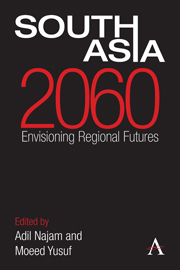Book contents
- Frontmatter
- Contents
- Acknowledgments
- List of Abbreviations
- Introduction: Imagining South Asian Futures
- Section I South Asia as a Region
- Section II State Relations
- Chapter 6 The Future of Democracy
- Chapter 7 Conflict and Reconciliation: Three Scenarios
- Chapter 8 Religion and State Formation
- Chapter 9 Will South Asia Still Be Terrorism's Center of Gravity?
- Chapter 10 Speculations on Nuclear South Asia
- Chapter 11 Nuclear Risk: Overstated or Underrated?
- Chapter 12 The Shadow of the India–Pakistan Stalemate
- Chapter 13 Regional Integration
- Chapter 14 The Future of Integration
- Chapter 15 The Giant Neighbor: Why is China Important?
- Section III Development
- Section IV Human Well-Being
- About the Authors
- Bibliography
- Index
Chapter 12 - The Shadow of the India–Pakistan Stalemate
from Section II - State Relations
Published online by Cambridge University Press: 05 September 2013
- Frontmatter
- Contents
- Acknowledgments
- List of Abbreviations
- Introduction: Imagining South Asian Futures
- Section I South Asia as a Region
- Section II State Relations
- Chapter 6 The Future of Democracy
- Chapter 7 Conflict and Reconciliation: Three Scenarios
- Chapter 8 Religion and State Formation
- Chapter 9 Will South Asia Still Be Terrorism's Center of Gravity?
- Chapter 10 Speculations on Nuclear South Asia
- Chapter 11 Nuclear Risk: Overstated or Underrated?
- Chapter 12 The Shadow of the India–Pakistan Stalemate
- Chapter 13 Regional Integration
- Chapter 14 The Future of Integration
- Chapter 15 The Giant Neighbor: Why is China Important?
- Section III Development
- Section IV Human Well-Being
- About the Authors
- Bibliography
- Index
Summary
South Asia today is among the few regions in the world moving at a snail's speed towards greater regional cooperation that can empower its constituent nations with the means to address common challenges and benefit from opportunities offered by globalization. One of the principal factors for the lack of progress towards an integrated and cooperative South Asia is the decades-old state of unresolved tensions between the region's two largest countries and economies: India and Pakistan.
South Asia is unique because it includes three of the world's ten most populated countries with all the complex challenges these demographics mean for fighting poverty and fostering prosperity. But it is India and Pakistan that account for much of the region's population, economic output, military strength and of course nuclear capability. Between them they overshadow the rest of the region. In many crucial respects the fate and fortunes of South Asia depends on the future trajectory of the India–Pakistan relationship that will likely define the destiny of the region as a whole.
If these two countries are able to break from their troubled past, South Asia will move towards greater integration with peace dividends for all the member states of the South Asian Association for Regional Cooperation (SAARC). Should they fail to escape their past, individual countries will perform differently – some will still do better than others – but the region as a whole will be unable to realize its vast and promising potential.
- Type
- Chapter
- Information
- South Asia 2060Envisioning Regional Futures, pp. 96 - 101Publisher: Anthem PressPrint publication year: 2013



